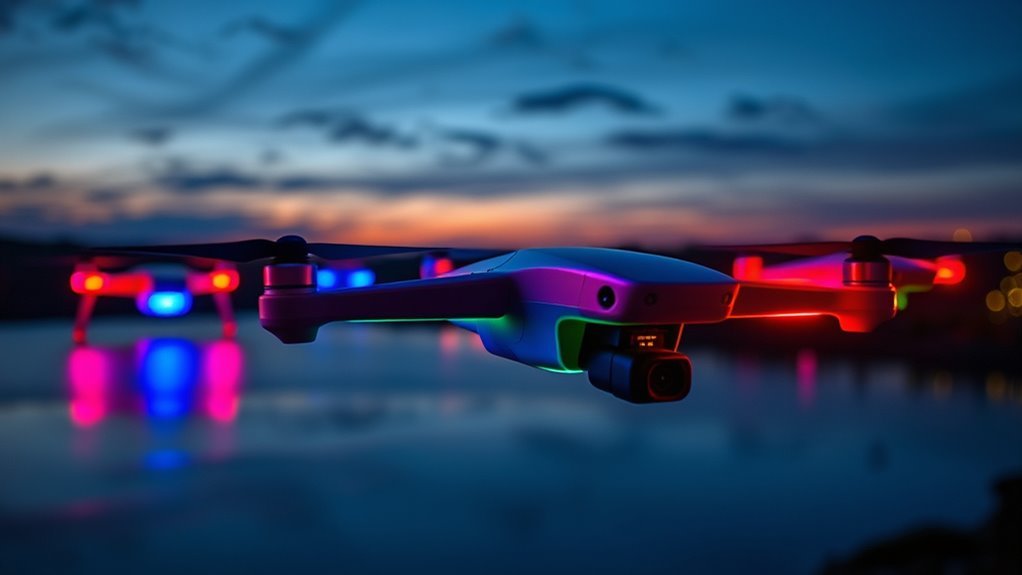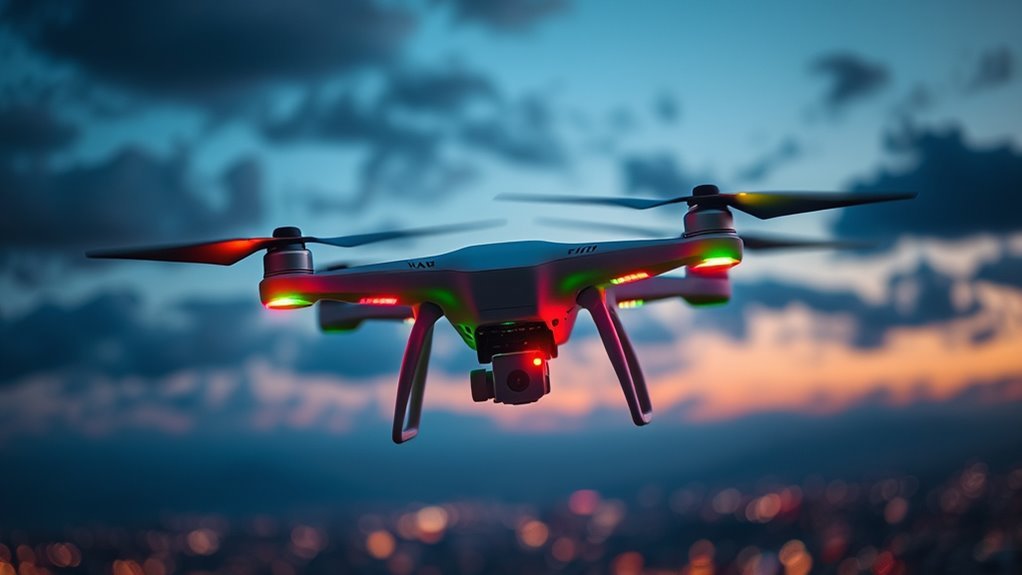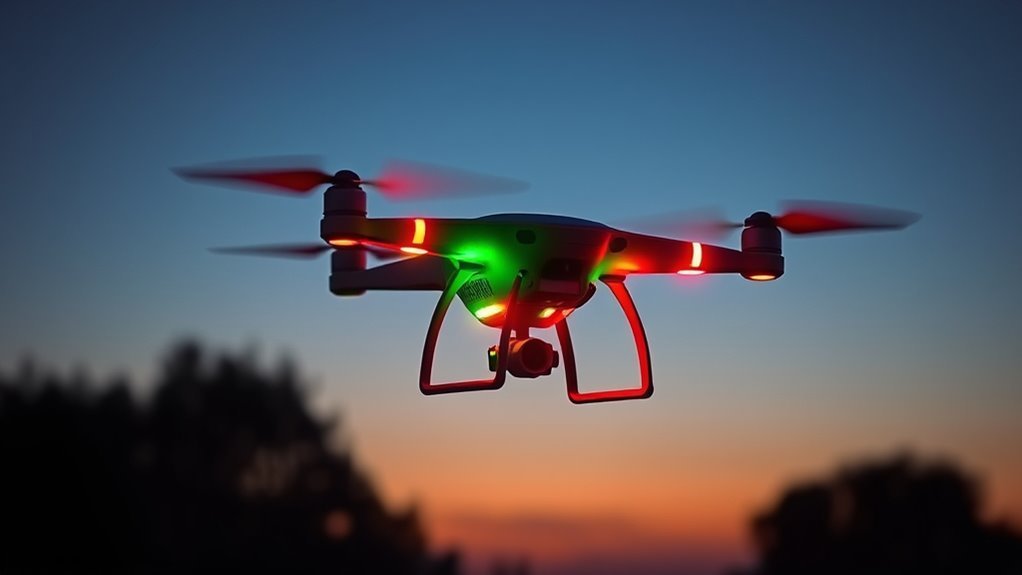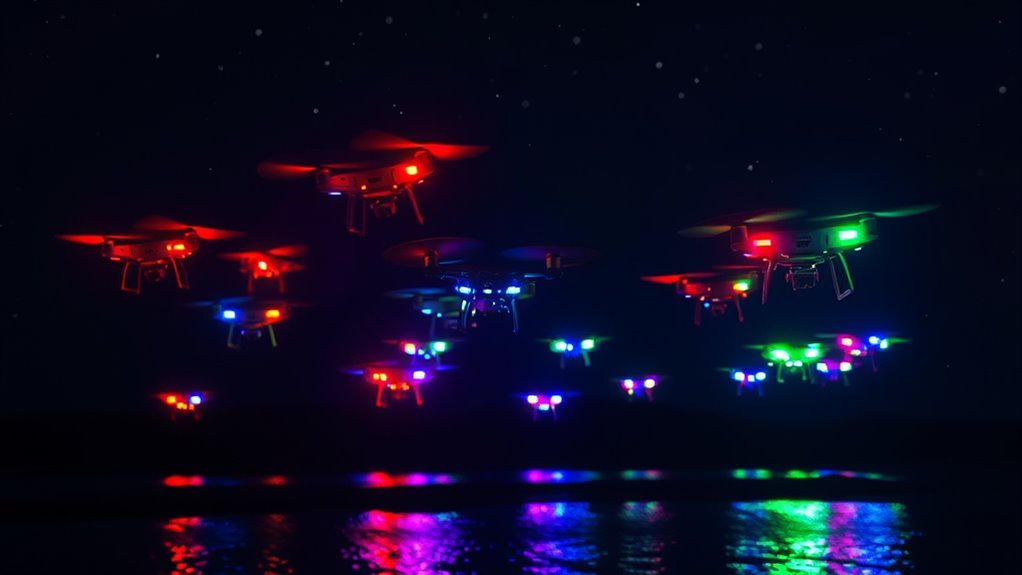Drones are equipped with various lighting systems to enhance visibility and safety. Key types include strobe lights for high-intensity visibility, position lights indicating orientation, landing lights for illumination during landings, and camera lights that optimize low-light photography. Identification lights communicate drone status, helping maintain situational awareness. Compliance with regulations guarantees these lights are effective for safe operations. Explore the specific functions and benefits of each light type for a thorough understanding of drone lighting systems.
Overview of Drone Lighting Systems

Drone lighting systems play a crucial role in enhancing safety and functionality during operation. Effective drone visibility is critical, especially in low-light conditions or adverse weather. Advanced lighting technology, such as LED systems, provides ideal illumination, allowing operators to maintain situational awareness and navigate obstacles effectively. These systems often include strobe lights and colored indicators, which not only improve visibility for the operator but also alert other airspace users to the drone’s presence. By integrating smart lighting solutions, drones can adapt to various environments, ensuring compliance with regulations while promoting safety. Ultimately, understanding the importance of these lighting systems empowers operators to maximize their drone’s operational capabilities and enhances overall flight safety.
Navigation Lights

Navigation lights serve a critical function in ensuring the safety and visibility of drones during flight. You’ll encounter various types of navigation lights, each designed to convey specific information about the drone’s position and direction. Understanding these lights is essential for effective operation and compliance with aviation regulations.
Purpose of Navigation Lights
In the domain of aerial operations, navigation lights play an essential role in ensuring safety and situational awareness. For drone operators, these lights enhance drone visibility, making it easier to spot aircraft in various environments, especially during low-light conditions. The integration of advanced lighting technology allows drones to emit distinct signals that communicate their position and orientation to other pilots and ground personnel. This functionality is critical for avoiding collisions and maintaining safe distances between aerial vehicles. Moreover, navigation lights aid in compliance with aviation regulations, fostering a culture of safety and responsibility among drone users. Ultimately, effective use of navigation lights empowers you to operate your drone with confidence and freedom, knowing you’re visible and accountable in the skies.
Types of Navigation Lights
A variety of navigation lights are essential for guaranteeing the safe operation of drones in diverse environments. Understanding the types of navigation lights will enhance your experience, especially during night flying. Here’s a breakdown of common navigation lights you might encounter:
| Light Type | Description |
|---|---|
| Strobe Lights | High-intensity, flashing lights for visibility. |
| Position Lights | Steady lights that indicate the drone’s orientation. |
| Anti-Collision | Bright lights to prevent mid-air collisions. |
| Landing Lights | Bright lights focused on the landing area. |
| Beacon Lights | Pulsing lights that signal for attention. |
With advancements in light technology, you can guarantee your drone stands out, promoting both safety and freedom in the skies.
Strobe Lights

While many might overlook the importance of strobe lights on drones, these devices play an essential role in enhancing visibility and safety during flight operations. Strobe functionality allows drones to emit intense bursts of light, making them discernible even in low-light conditions. This feature is critical for avoiding collisions, especially in crowded airspaces. Strobe regulations often mandate the use of such lights, particularly for larger drones operating at night or in regulated environments. By adhering to these regulations, you guarantee not only compliance but also promote the safety of your operations. Ultimately, integrating strobe lights into your drone setup is a significant step toward achieving greater operational freedom while maintaining the necessary safety standards. Additionally, collision avoidance systems are essential for preventing mid-air collisions during performances.
Position Lights
Position lights are essential for indicating a drone’s orientation during flight. You’ll need to understand the various types of position lights, their specific functions, and the regulations governing their use. This knowledge guarantees not only compliance but also enhances safety in the airspace.
Types of Position Lights
When operating drones, understanding the various types of position lights is vital for guaranteeing safety and compliance with aviation regulations. Position light colors play a significant role in drone light visibility, helping you identify the orientation and movement of your drone in the sky. Here are three common types of position lights you should be aware of:
- Red Lights: Indicate the left side of the drone.
- Green Lights: Represent the right side of the drone.
- White Lights: Typically used for the rear, providing overall visibility.
Familiarizing yourself with these types guarantees you can operate your drone responsibly while enhancing safety measures during night flights or low-light conditions.
Function of Position Lights
Understanding the function of position lights is vital for effective drone operation, especially in varying visibility conditions. Position light functionality is essential for indicating a drone’s orientation and direction to other aircraft and ground observers. These lights typically consist of red, green, and white colors, each serving a specific purpose: red on the left, green on the right, and white at the rear. This arrangement guarantees that you can easily identify the drone’s heading, which enhances situational awareness during flight. Additionally, position light visibility plays an important role in making sure that your drone remains detectable in low-light environments. By adhering to these lighting principles, you not only promote safety but also embrace the freedom to operate your drone confidently in diverse conditions.
Regulations for Position Lights
While operating drones, it’s essential to be aware of the regulations governing position lights, as non-compliance can lead to safety hazards and legal repercussions. Understanding these position light regulations guarantees you’re flying responsibly. Here are key drone light requirements to keep in mind:
- Color Specifications: Position lights must display specific colors—typically red on the left and green on the right.
- Visibility Range: These lights should be visible from a distance of at least 3 statute miles in good conditions.
- Operational Hours: Position lights must be activated during twilight and nighttime operations to enhance visibility.
Adhering to these guidelines not only keeps you compliant but also promotes safety in shared airspace.
Landing Lights
Although many may overlook the importance of landing lights in drone operations, these systems play an essential role in ensuring safe and efficient landings. You need to understand the different landing light types, as they can vary in intensity and beam configuration. For instance, some drones use LED lights for broader visibility, while others might employ halogen lights for enhanced brightness. Proper landing light placement is vital; positioning them near the front and underside of the drone can illuminate the landing area effectively. This setup allows you to assess terrain conditions and avoid obstacles during the descent. By prioritizing appropriate landing light types and placement, you’ll enhance your drone’s operational safety and efficiency, ensuring a smooth landing every time.
Beacon Lights
Beacon lights serve a critical purpose in enhancing the visibility and safety of drones during operations, especially in low-light conditions. You’ll encounter various types of beacon lights, each designed to meet specific regulatory requirements and operational needs. Understanding the regulations and compliance standards surrounding these lights is essential for ensuring safe and legal drone usage.
Purpose of Beacon Lights
In the domain of drone operation, beacon lights serve a critical function by enhancing visibility and safety. Understanding the purpose of these lights is essential for your drone’s effective use. Here are three key aspects:
- Increased Visibility: Beacon lights make your drone more noticeable in various environments, reducing the risk of collisions.
- Compliance with Regulations: Familiarity with beacon light regulations guarantees you operate within legal boundaries, promoting responsible flying.
- Orientation and Navigation: These lights assist in maintaining your drone’s orientation, especially in low-light or complex environments.
Types of Beacon Lights
Understanding the various types of beacon lights is important for optimizing your drone’s visibility and functionality. There are several beacon light types to evaluate. Strobe lights are highly effective for daytime visibility, emitting quick bursts of light that catch the eye. LED lights offer versatility, often providing multiple colors and flash patterns to suit different operational needs. Then you have navigation lights, which indicate your drone’s position and orientation, enhancing safety during flight. Finally, infrared lights cater to night vision applications, allowing for stealthy operations without compromising visibility for those equipped with night vision gear. By selecting the appropriate beacon light types, you can greatly enhance your drone visibility and guarantee compliance with safety standards.
Regulations and Compliance
To guarantee compliance with aviation regulations, it is crucial to take into account the specific requirements for beacon lights on drones. Understanding these drone regulations can help you avoid fines and guarantee safe operations. Here are three key compliance standards you should follow:
- Visibility: Your beacon lights must be visible from a specific distance, typically at least three statute miles, to guarantee they’re noticed by other airspace users.
- Color: You’ll need to use specific colors, such as red or white, as mandated for certain operational conditions to enhance visibility.
- Operational Status: Confirm your beacon lights are operational during night flights or low-visibility conditions, as required by many regulatory bodies.
Adhering to these standards not only keeps you compliant but also promotes safer skies for everyone.
Camera Lights
While capturing high-quality imagery from drones, camera lights play an essential role in enhancing visibility and detail, particularly in low-light conditions. By optimizing your camera settings, you can greatly improve low light performance, ensuring that your shots remain clear and vibrant. Drones equipped with powerful LED camera lights allow for greater flexibility, enabling you to shoot in dusk or dawn scenarios without compromising quality. These lights illuminate the scene, highlighting textures and colors that might otherwise be lost in darkness. Additionally, using adjustable camera lights lets you fine-tune exposure settings, balancing brightness and contrast. This technical enhancement not only elevates your visual storytelling but also grants you the freedom to explore new creative horizons in aerial photography. The ability to capture superior image quality allows for advanced photography techniques that enhance the overall visual impact of your work. Moreover, Anzu’s camera features exceptional low-light capabilities that help in achieving crisp images even in challenging lighting conditions.
Identification Lights
Identification lights are essential for ensuring the safety and visibility of drones during flight, especially in crowded or low-light environments. These lights help distinguish your drone from others and enhance situational awareness. Here are three key aspects to reflect upon:
- Identification Colors: Different colors can indicate various statuses. For example, green typically signifies a ready state, while red may indicate low battery or an emergency.
- Identification Patterns: Blinking or solid light patterns can communicate different actions or statuses, like takeoff or landing.
- Regulatory Compliance: Many regions have specific regulations regarding identification lights, so ensuring your drone meets these requirements is vital for legal operation.
Safety Features of Drone Lights
Effective identification lights not only serve to distinguish drones but also incorporate several safety features that enhance operational security. These lights considerably improve light visibility, ensuring that your drone remains detectable, especially during low-light conditions. By adhering to established standards, such as FAA regulations, you can boost drone safety while flying in congested areas or near other aircraft. The use of color-coded lights aids in quick identification, allowing for safer navigation. In addition, integrated blink patterns can signal specific maneuvers or warnings to nearby pilots and ground observers. By prioritizing these safety features, you empower yourself to operate your drone with greater confidence and awareness, ultimately preserving the freedom to explore the skies responsibly and without incident. Furthermore, understanding federal oversight can help drone operators comply with legal requirements while enhancing safety. Incorporating signal reliability into your drone operations ensures consistent performance in various environments.
Enhancing Aerial Photography With Lights
As you explore the potential of aerial photography, integrating lights into your drone setup can greatly enhance image quality and creative possibilities. Utilizing effective lighting techniques can transform your aerial composition, allowing for stunning visuals even in low-light conditions. Here are three key benefits of adding lights to your drone:
- Increased Visibility: Bright lights can highlight details in dark landscapes, enhancing the overall clarity of your images.
- Mood and Atmosphere: Different lighting setups can evoke specific emotional responses, adding depth to your aerial shots.
- Unique Perspectives: Experimenting with various angles and light sources can create dynamic contrasts, leading to innovative aerial compositions.
Frequently Asked Questions
Can Drone Lights Be Customized for Specific Flying Conditions?
Yes, you can customize drone lights for specific flying conditions using custom light configurations and adaptive lighting systems. This flexibility enhances visibility and safety, allowing you to optimize performance based on environmental factors and operational needs.
Are There Regulations Governing Drone Light Colors?
Yes, there’re regulations governing drone light colors, ensuring regulatory compliance with light color standards. You must adhere to these guidelines, which enhance visibility and safety, allowing you to operate freely while following necessary legal frameworks.
How Do Drone Lights Impact Battery Life?
You might think drone lights don’t affect battery life, but higher light intensity can reduce battery efficiency. Managing light usage is essential for extending flight time, giving you the freedom to explore longer without interruptions.
What Materials Are Used for Drone Light Housings?
When considering light housing materials, you’ll find options like plastic and aluminum, often enhanced with reflective coatings. These choices balance durability, weight, and heat resistance, ensuring peak performance while maintaining the freedom for innovative designs.
How Do Weather Conditions Affect Drone Lighting Performance?
Weather conditions greatly affect drone visibility. Rain, fog, or snow can diminish light performance, reducing the drone’s visibility to observers. You’ll need to take into account these factors when planning your flight to guarantee maximum safety and effectiveness.

